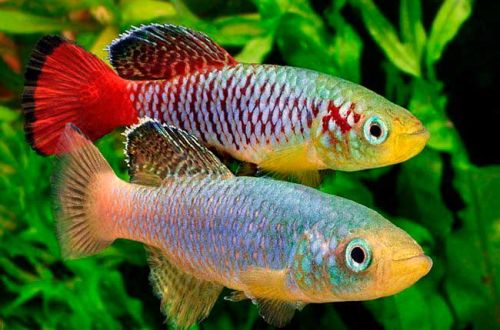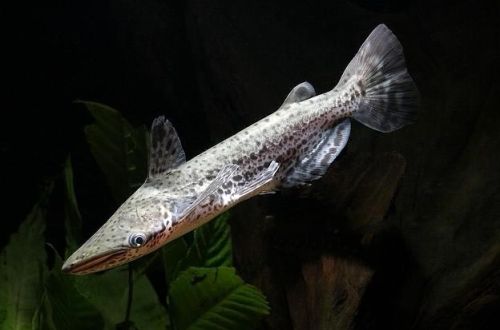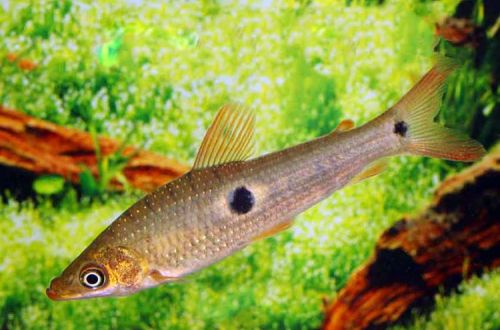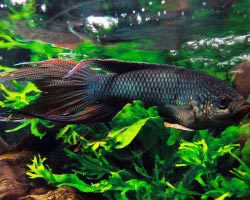
Gourami
Gourami is the collective name of fish belonging to the families Macropods (scientific Osphronemidae), Crawlers or Anabassids (scientific Anabantidae) and Helestomoves (scientific Helostomatidae). The word “gourami” itself is of Javanese origin and loosely translated means “a fish sticking its nose out of the water.” Widespread in
Contents
- Description
- Behavior
- Content
- Breeding
- Pink Gourami
- Blue Gourami
- Lyalius
- Fire Gourami
- Giant Gourami
- Redtail Gourami
- Golden Gourami
- Honey Gourami
- kissing gourami
- Lunar Gourami
- Neon Gourami
- Marble Gourami
- Macropod
- Pearl Gourami
- Platinum Gourami
- Blue Lyalius
- Snake Gourami
- Thick Lipped Gourami
- Macropod black
- Macropod round-tailed
- Kupanus deya
- Kupanus dark
- Kupanus Deissner
- Gourami grumbling
- Dwarf Gourami
- Pensive gourami
- Labiosis
- striped gourami
- Bellontia Signata
- Belotonia Hasselda
- Chocolate Gourami
- chameleon fish
- Creeper fish
- Ctenopoma
- Ctenopoma leopard
- Exquisite Ctenopoma
- Fish-leaf
- Cresser’s paradise fish
- Gourami ocellatus
- Selatan
- False chocolate
- big chocolate
- Veilant’s gourami
- Gourami Schaller
Description
All types are similar to each other. They have large laterally compressed, dorsal and anal fins stretching from head to tail. The pelvic fins are modified and resemble thin threads. They are dotted with sensitive receptors with which the fish explores the surrounding space. In nature, they help to navigate among dense thickets of plants.
Behavior
Calm peace-loving fish, but this primarily applies to females. Males are not very friendly to each other. During the breeding season or in conditions of lack of space (overcrowding of the aquarium), aggression is possible, and in relation to other species too. Therefore, the most acceptable option is keeping in a spacious aquarium in the ratio of one male to several females.
It is worth noting that some species, such as Macropods, are extremely warlike and are usually kept alone.
Content
They are easy to keep, do not require special conditions, perfectly adapt to a wide range of pH and dGH values, and can successfully adapt to life in a semi-empty aquarium. The labyrinth organ makes them quite hardy, so the fish can “forgive” some omissions on the part of the aquarist, such as irregular cleaning of the aquarium and reducing the water quality to a level unacceptable for most other fish. But before that, of course, it is better not to bring it.
Breeding
During the breeding season, males build special
Pink Gourami
The pink kissing gourami, scientific name Helostoma temminkii, belongs to the family Helostomatidae
Blue Gourami
Blue gourami, scientific name Trichopodus trichopterus, belongs to the family Osphronemidae
Lyalius
Lalius, scientific name Trichogaster lalius, belongs to the family Osphronemidae
Fire Gourami
Fire Gourami or Fire Lalius, scientific name Trichogaster lalius, belongs to the family Osphronemidae
Giant Gourami
The giant gourami, scientific name Osphronemus goramy, belongs to the family Osphronemidae
Redtail Gourami
The giant red-tailed gourami, scientific name Osphronemus laticlavius, belongs to the family Osphronemidae
Golden Gourami
Golden Gourami, scientific name Trichopodus trichopterus, belongs to the family Osphronemidae
Honey Gourami
Honey gourami, scientific name Trichogaster chuna, belongs to the family Osphronemidae
kissing gourami
Kissing gourami, scientific name Helostoma temminkii, belongs to the family Helostomatidae
Lunar Gourami
Moon gourami, scientific name Trichogaster microlepis, belongs to the family Osphronemidae
Neon Gourami
Neon gourami, scientific name Trichogaster lalius, belongs to the family Osphronemidae
Marble Gourami
Marble Gourami, scientific name Trichopodus trichopterus, belongs to the family Osphronemidae
Macropod
Macropod or Paradise fish, scientific name Macropodus opercularis, belongs to the family Osphronemidae
Pearl Gourami
Pearl Gourami, scientific name Trichopodus leerii, belongs to the family Osphronemidae
Platinum Gourami
Platinum gourami, scientific name Trichopodus trichopterus, belongs to the family Osphronemidae
Blue Lyalius
Blue Lalius, scientific name Trichogaster lalius, belongs to the family Osphronemidae
Snake Gourami
The snake gourami, scientific name Trichopodus pectoralis, belongs to the family Osphronemidae
Thick Lipped Gourami
Thick-lipped Gourami or Labiosa, scientific name Trichogaster labiosa, belongs to the family Osphronemidae
Macropod black
 Black macropod, scientific name Macropodus spechti, belongs to the family Osphronemidae
Black macropod, scientific name Macropodus spechti, belongs to the family Osphronemidae
Macropod round-tailed
The round-tailed macropod or Chinese paradise fish, scientific name Macropodus ocellatus, belongs to the family Osphronemidae
Kupanus deya
Kupanus deya, scientific name Pseudosphromenus dayi, belongs to the family Osphronemidae
Kupanus dark
Dark Parosphromenus, scientific name Parosphromenus nagyi, belongs to the family Osphronemidae
Kupanus Deissner
Parosphromenus Deissner, scientific name Parosphromenus deissneri, belongs to the family Osphronemidae
Gourami grumbling
Grumbling gourami, scientific name Trichopsis vittata, belongs to the family Osphronemidae
Dwarf Gourami
Dwarf gourami or Pumila, scientific name Trichopsis pumila, belongs to the family Osphronemidae
Pensive gourami
Thread-bearer, Ctenops noble or Pensive gourami, scientific name Ctenops nobilis, belongs to the family Osphronemidae
Labiosis
Labiosa, scientific name Trichogaster labiosa, belongs to the family Osphronemidae
striped gourami
Striped Colisa, Striped Gourami or Banded Gourami, scientific name Trichogaster fasciata, belongs to the family Osphronemidae
Bellontia Signata
Belontia Signata, scientific name Belontia signata, belongs to the family Osphronemidae
Belotonia Hasselda
Hasseld’s Belothonia or Honeycomb-tailed macropod, scientific name Belontia hasselti, belongs to the family Osphronemidae
Chocolate Gourami
Chocolate gourami, scientific name Sphaerichthys osphromenoides, belongs to the family Osphronemidae
chameleon fish
Badis, Badis Chameleon or Chameleon Fish, scientific name Badis badis, belongs to the family Badidae
Creeper fish
Anabas or Creeper Fish, scientific name Anabas testudineus, belongs to the family Anabantidae
Ctenopoma
Ctenopoma eight-striped, scientific name Microctenopoma fasciolatum, belongs to the family Anabantidae
Ctenopoma leopard
Ctenopoma leopard, scientific name Ctenopoma acutirostre, belongs to the family Anabantidae
Exquisite Ctenopoma
Ctenopoma Ansorg or Exquisite Ctenopoma, scientific name Microctenopoma ansorgii, belongs to the family Anabantidae
Fish-leaf
Leaf fish, scientific name Monocirrhus polyacanthus, belongs to the family Polycentridae
Cresser’s paradise fish
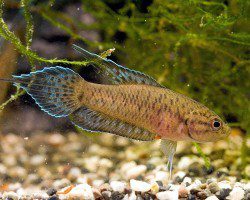 Malpulutta Kretsera or Paradise fish Crestsera, scientific name Malpulutta kretseri, belongs to the family Osphronemidae
Malpulutta Kretsera or Paradise fish Crestsera, scientific name Malpulutta kretseri, belongs to the family Osphronemidae
Gourami ocellatus
Gourami ocelatus or Ocellated Parasphericht, scientific name Parasphaerichthys ocellatus, belongs to the family Osphronemidae
Selatan
Cross Chocolate Gourami or Selatan Gourami, scientific name Sphaerichthys selatanensis, belongs to the family Osphronemidae
False chocolate
False chocolate gourami, scientific name Parasphaerichthys lineatus, belongs to the family Osphronemidae
big chocolate
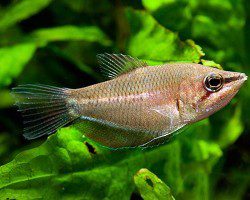 The giant chocolate gourami, scientific name Sphaerichthys acrostoma, belongs to the family Osphronemidae
The giant chocolate gourami, scientific name Sphaerichthys acrostoma, belongs to the family Osphronemidae
Veilant’s gourami
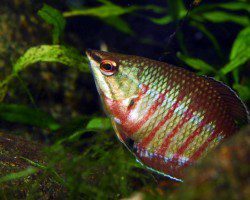 Veilant’s gourami, scientific name Sphaerichthys vaillanti, belongs to the family Osphronemidae
Veilant’s gourami, scientific name Sphaerichthys vaillanti, belongs to the family Osphronemidae
Gourami Schaller
Schaller gourami, scientific name Trichopsis Schaller, belongs to the family Osphronemidae



